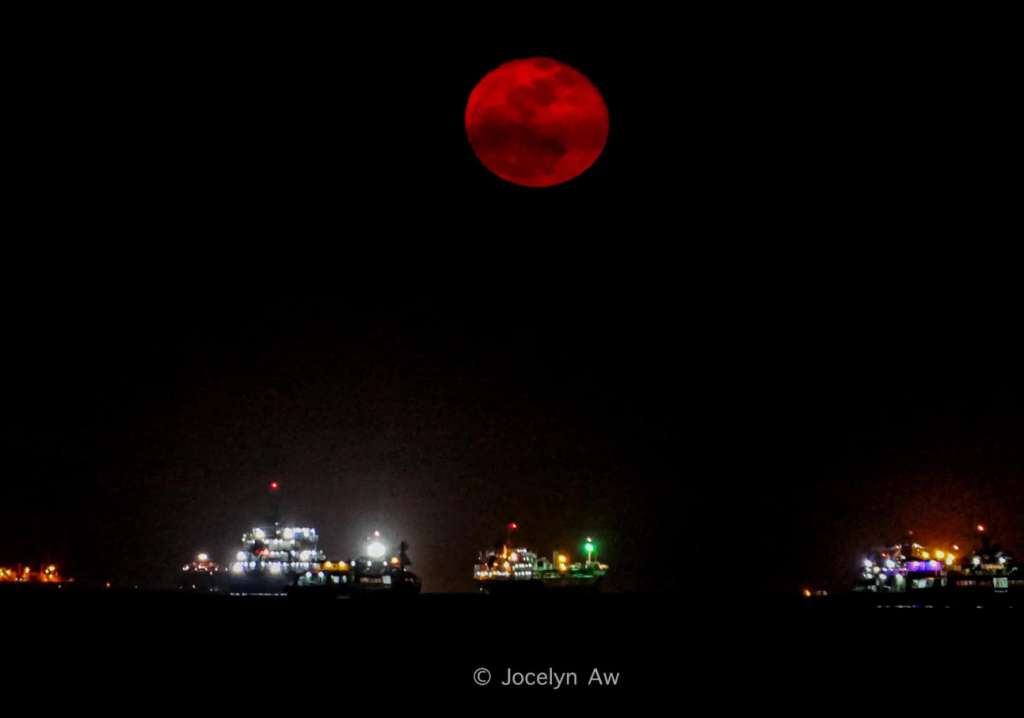On September 1, 2023, just one day after the mesmerizing Blue Moon supermoon, Singaporeans were treated to another breathtaking celestial event—a vivid red moon. This stunning phenomenon captured the attention of sky enthusiasts across the island, who eagerly shared their photos on social media.
However, it’s crucial not to confuse this captivating red moon with the well-known blood moon.
The Distinction: Red Moon vs. Blood Moon
Before we explore the captivating hues of the Sep. 1 red moon, it’s essential to clarify the key difference between a red moon and a blood moon. A blood moon occurs during a total lunar eclipse, when the moon finds itself within the darkest part of Earth’s shadow, known as the umbra. During this eclipse, the moon takes on a reddish hue, giving rise to its dramatic name. NASA explains that this reddish appearance results from the scattering of sunlight through Earth’s atmosphere, which refracts the shorter blue wavelengths and allows the longer red wavelengths to dominate.
The Facebook user who posted the photos said:

1 Sep 2023 – 1 day after full moon. The super sturgeon bluemoon tonight is spectacular, even better than yesterday as it is visible lower in the horizon, which gave it this amazing red hue not seen in yesterday’s rising moon.

These few shots were taken between 8.51pm to 9.01pm, they show the evolution of the moon colours from shocking red (Red Bluemoon!) to golden in 10 mins!
8.51pm – it first appeared above the horizon, the globe first appeared red fuzzy and blurry.
8.52pm and 8.54pm – the moon became clearer and clearer, turning into blood red globe.
8.57pm – the moon started to lose its redness and turned orangey.
8.59pm – the moon is now a big golden globe.
9.01pm – the big golden moon on a wider frame, so beautiful.
Simply spectacular!
Images Source: Jocelyn Aw/ CloudSpotting & SkySpotting Singapore/Facebook
The Natural Color of the Moon
Contrary to the red moon’s vibrant appearance, the moon’s natural color is quite different. When its dusty surface is illuminated by the sun, the moon adopts an off-white, brown-grayish tone, as revealed by National Geographic.
The Role of Earth’s Atmosphere
So, why does the moon change its color to such striking shades like red? The answer lies in Earth’s atmosphere. When we view the moon through the layers of Earth’s atmosphere, which contain stratified and irregular gas layers, various colors become visible. This phenomenon occurs due to the scattering of light by tiny air molecules present in these atmospheric layers. Interestingly, blue light scatters more readily than red or orange light due to its shorter wavelength.

The Spectacle of Colors
The scattering of light and the unique structure of Earth’s atmosphere combine to create the spectacle of colors we witness when gazing at the moon. The red, orange, and yellow wavelengths of light are less scattered and are thus able to pass through the atmosphere with greater ease, reaching our eyes in all their glory.
The Sep. 1 Red Moon
In the case of the Sep. 1 red moon, its vibrant appearance was likely due to its proximity to the horizon. When the moon is near the horizon, it appears to pass through a larger portion of Earth’s atmosphere. This elongated path results in the scattering of shorter wavelengths and allows the longer wavelengths to dominate, giving the moon its fiery red hue. NASA’s explanation sheds light on this captivating occurrence.
Atmospheric Influences
It’s worth noting that various particles and conditions in Earth’s atmosphere can influence the path of light and, consequently, the moon’s color as perceived by the human eye. These atmospheric factors add an extra layer of complexity to the ever-changing palette of the night sky.
Conclusion
The red moon that graced Singapore’s night sky on September 1, 2023, was a visual treat for all who had the opportunity to witness it. This celestial spectacle, distinct from the renowned blood moon, was a result of the moon’s interaction with Earth’s atmosphere and its position near the horizon. As we continue to explore the wonders of the cosmos, such events remind us of the beauty and intricacy of our universe.
